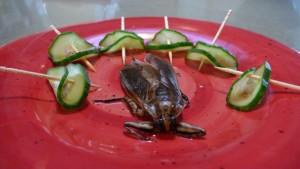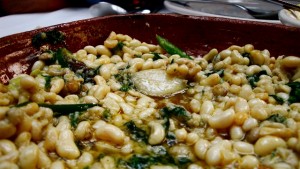"Insects do not taste like chicken," said Daniella Martin, a charismatic advocate of eating low, make that really low, on the food chain. Through public lectures, cooking demonstrations and her Girl Meets Bug web site, Martin preaches the gospel of why, in her opinion, more people should munch on mealworms, crunch a cricket or feast on plump bee larvae.

Still, it's a hard sell to convince even intrepid foodies to incorporate edible insects into the culinary rotation. While making this story, Daniella shared with me and the camera crew a dish consisting of fileted strips of Thai waterbug atop cucumber slices. She described this exotic insect's flavor as "this complex kind of a Jolly Rancher soaked in banana peel perfume with a hint of melon and green apple and anchovy."
I can't concur with this florid description of an insect with a face only a mother could love as I missed the opportunity to sample this particular dish. Still, the description offered an opportunity for Daniella to share with me a few of the interesting flavors and textures which recur among the roughly 1700 insects which are thought to be edible. At the time of our filming in late November, Daniella had eaten between 20 to 25 different kinds of edible insects, making her as good of an authority as any I'd encounter within the flavor "galaxy", as she put it, of this unusual cuisine.
"Crickets and things that hop, for instance, grasshoppers – they all have a bit of a nutty flavor," she said, adding that "larvae, for instance, often taste rich and buttery...sort of bacon-y. And then some of the smaller ones taste a little bit like mushrooms."

While making this story, I also had the opportunity to meet Norm Gershenz, the gracious and passionate Executive Director of SaveNature, an NGO dedicated to environmental education and the conservation of diverse habitats around the world, from Namibia to Palau. We filmed with Daniella Martin in his Insect Discovery Lab where the two of them talked about various insects, some of which were edible and some were not, such as the eastern lubber grasshopper. Its bright coloration serves as a warning to would-be predators that it sequesters nasty chemicals, making it an unappetizing meal. Green-colored grasshoppers, on the other hand, are safe to eat, as are mealworms which are the juvenile stage of darkling beetles. The beetles, on the other hand, do not make a tasty morsel.


